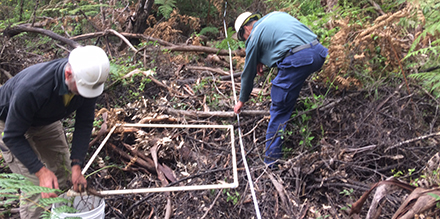Peer-reviewed research published in the Australian Forestry journal has confirmed something that forest firefighters have long known: if forests are left unburned for many years, they still carry heavy bushfire fuels, making firefighting difficult and dangerous. Source: Timberbiz
The new research demolishes the theory that if forests are left unburnt, they become non-flammable.
The study was conducted by internationally recognised bushfire scientist Dr Neil Burrows supported by colleagues Alan Wills and Dr Val Densmore. Working in the field, rather than with computer models, the scientists measured and analysed fuels in karri forests that ranged from 1 to 92 years since last being burned.
Their findings confirmed long-held field experience. After a fire, the karri forest begins almost immediately to start re-accumulating bushfire fuels. These comprise fallen leaves, bark and twigs, some heavier woody material and regrowth of understorey. For the first 30 years or so after the fire, the weight of flammable fuel continues to increase year by year, but then it begins to plateau, as the rate of new fuel accumulation approximates the rate of natural decomposition.
The critical finding is that the maximum fuel weight at about fuel-age 30 is about 50 tonnes of fuel on every hectare of forest, and this declines only slightly over subsequent decades. This level of fuel generates high-intensity bushfires which are difficult or impossible to control. The structure and composition of the shrub layer changes over time since fire, but even at its maximum height and density, contributes little fuel.
The scientists examined and measured fuels at 72 sites across the karri forest region, including areas where karri grows in conjunction with tingle trees. They did not find a single example of bushfire fuels disappearing or becoming insignificant, even in areas left unburnt for almost a century.
The scientists concluded that periodic low-intensity prescribed burning of karri forests (at an interval of about 8 years) will maintain bushfire fuels and understorey fire hazard at levels that will reduce the rate of spread, fire intensity, flame dimensions and spotting potential of bushfires. This makes bushfires easier and safer to suppress, and less damaging.
A favourite line of those who oppose fuel-reduction prescribed burning is that the burning makes the forest more, not less flammable, and that consequently burning should cease. This theory is based on desk-top computer modelling, not on actual field studies. The new research demonstrates that, for the karri forest at least, the computer modelling does not reflect the situation in the real world and provides no basis for constraining or ceasing fuel reduction burning.
The Bushfire Front is pleased that this research has been done and that the results so comprehensively support the WA government’s wise policy of periodically carrying out fuel reduction prescribed burning in our south-west forests.
The paper is available to download here.






